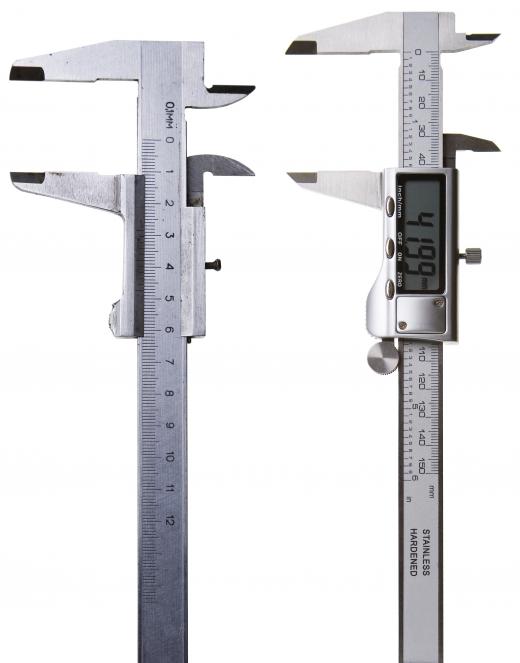A vernier caliper is a measuring device which takes advantage of a vernier scale, a scale used to provide very precise measurements. The vernier adds an extra digit of accuracy to any measurement, allowing it to be highly accurate. Vernier calipers are commonly found in scientific laboratories, where people may want to be able to make high precision measurements in the course of research or sample analysis. Specialty vernier calipers can even be fitted to microscopes.
Like other calipers, a vernier caliper has an L-shaped design with a movable arm. The movable arm can be slid out to allow an object to fit between the arms, and a measurement can be taken. Some calipers also have a set of smaller arms for the purpose of taking internal measurements, such as a measurement of internal diameter, and may have a depth probe for the purpose of measuring depth, as well.

Vernier calipers have two scales. The main scale is fixed, while the vernier, the secondary scale, slides along the main scale as the movable arm is shifted. Measurements are taken by looking for the mark on the main scale which is just to the left of the zero on the vernier caliper for the first measurement, and then looking to see which mark on the vernier caliper comes most closely into alignment with a mark on the main scale. This yields a secondary measurement.
For example, if the zero on the vernier caliper is just to the right of the 2.3 mark on the main scale, 2.3 would be the first measurement. If the seven mark on the vernier caliper is lined up with another mark on the main scale, the second measurement is seven, for a total measurement of 2.37. If the zero on the vernier is lined up perfectly with a number on the main scale, such as 4.5, the measurement will be 4.50. Reading a vernier caliper is easy to learn, and the error rate is generally very low, especially since most have locking screws which allow people to lock the movable arm in place so that the vernier caliper can be closely examined without worrying about disturbing the object.
Like all scientific instruments, the vernier caliper must be well cared for. It is important to make sure that the instrument is calibrated properly. When the movable arm is fully closed, the zero on the vernier scale should line up with the zero on the main scale. If it does not, the device needs to be serviced so that the two lines will align. Vernier calipers for measuring within metric and American systems of measurement are available.
Ever since she began contributing to the site several years ago, Mary has embraced the exciting challenge of being a About Mechanics researcher and writer. Mary has a liberal arts degree from Goddard College and spends her free time reading, cooking, and exploring the great outdoors.

